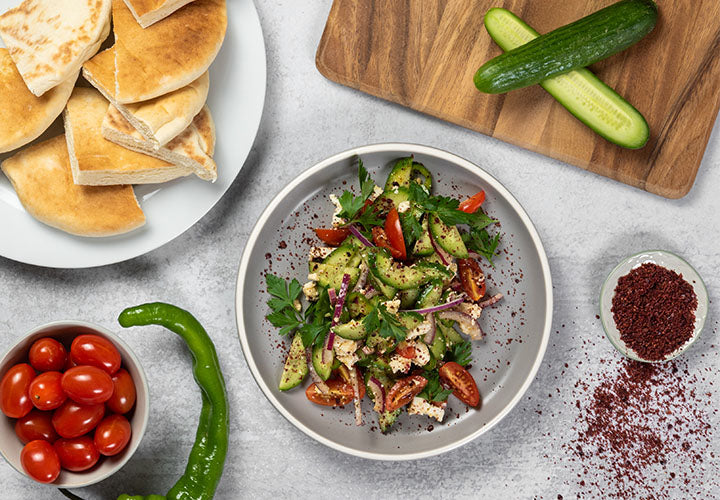02.10.2020
Spice Spotlight: Sumac

If you find yourself in the countryside of southern Turkey, you might notice some small trees with crimson clusters of upstanding berries growing around you. Head into any nearby restaurant and you will find these berries crushed and sprinkled on top of doner kebab and cucumber salad. That tangy, tart berry is sumac, one of the Middle East’s most important spices.
What is Sumac?
Sumac is a small flowering tree native to Iran that grows wild in Western Asia, the Arabian peninsula, and most of the Mediterranean. There are many species of sumac, but Rhus coriaria is the species that produces our beloved spice. The name sumac means “red” in medieval French, Latin, and Syrian languages. In addition to popular use as a spice, sumac was used to tan hides and is sometimes referred to as tanner’s sumac.
Sumac spice is harvested in the fall when berry clusters are fully developed. The berries are commonly sun-dried before they are finely ground for culinary use. The Spice House’s sumac comes from Gaziantep, Turkey where it is finely chopped fresh before it is cured in salt. This gives our sumac a nice salty flavor and helps preserve its lemony tang.
There is another variety of sumac that grows native in North America called staghorn sumac, Rhus typhina. If you live in the midwest, you’ve likely seen groves of these sumac trees alongside the highway. The fuzzy purple-red berries of this variety are also edible and taste and appear similar to Turkish sumac. Staghorn sumac was used by Native Americans to flavor tart beverages. Steep the buds in water, add a little sugar, and you have “Sumac-ade,” a popular American drink that was once marketed at traveling carnivals as pink lemonade.
What Does Sumac Taste Like?
Your palate will immediately notice a salty, lemon-like tartness, followed by fruity flavors of dried cranberry and cherry. There’s a nice earthiness behind everything as well.
 Sumac’s sharp, citrusy flavor makes it a popular substitute for lemon, particularly when less moisture is desired in a recipe. Sumac’s distinct tartness comes from malic acid, the same sour compound responsible for the tart flavor found in apples, grapes, and rhubarb.
Sumac’s sharp, citrusy flavor makes it a popular substitute for lemon, particularly when less moisture is desired in a recipe. Sumac’s distinct tartness comes from malic acid, the same sour compound responsible for the tart flavor found in apples, grapes, and rhubarb.
How is Sumac Used in Cooking?
Sumac is widely used as a condiment to finish dishes like hummus, baba ganoush, or fattoush salad. The spice is very popular in Turkish cuisine where it is sprinkled over rice, grilled meats, dips, and salads. The same way you find paprika replacing black pepper on the Hungarian dinner table, you will find sumac on the Turkish dinner table.
Before Romans encountered lemons in Northeast India, sumac was the most popular sour ingredient in Roman and neighboring cuisines. Today it is still preferred over lemon in many Mediterranean and Middle Eastern recipes for dry rubs, marinades, and salad dressings. Sumac is a crucial ingredient in Middle Eastern Za’atar seasoning. The Spice House’s Za’atar is Israeli-style—hand mixed from sumac, thyme, sesame seeds, hyssop, and oregano.
Sumac is a crucial ingredient in Middle Eastern Za’atar seasoning. The Spice House’s Za’atar is Israeli-style—hand mixed from sumac, thyme, sesame seeds, hyssop, and oregano.
Other herbs and spices that pair well with sumac are allspice, Urfa Biber pepper, cumin, coriander, parsley, mint, marjoram, clove, garlic, cardamom, and cinnamon.
Some popular ingredients to pair with the spice are yogurt, feta cheese, onions, cauliflower, tomato, eggplant, pomegranate, cucumber, carrots, bell pepper, lamb, fish, chicken, lentils, and chickpeas.
While most recipes that call for the spice are savory, you could use it as a garnish to add pleasant sour contrast to something sweet like a fruit salad or even vanilla ice cream.
Turkish Shepherd's Salad Recipe
 To celebrate our sumac’s Turkish origin, we tossed up a choban salad, also known as Turkish shepherd's salad. This dish is a nice side for any grilled meat, especially some heavily-spiced lamb.
To celebrate our sumac’s Turkish origin, we tossed up a choban salad, also known as Turkish shepherd's salad. This dish is a nice side for any grilled meat, especially some heavily-spiced lamb.
If you have a favorite recipe that calls for sumac, or questions on how to use it, let us know in the comments below.
Article by Geoff Marshall, Staff Writer